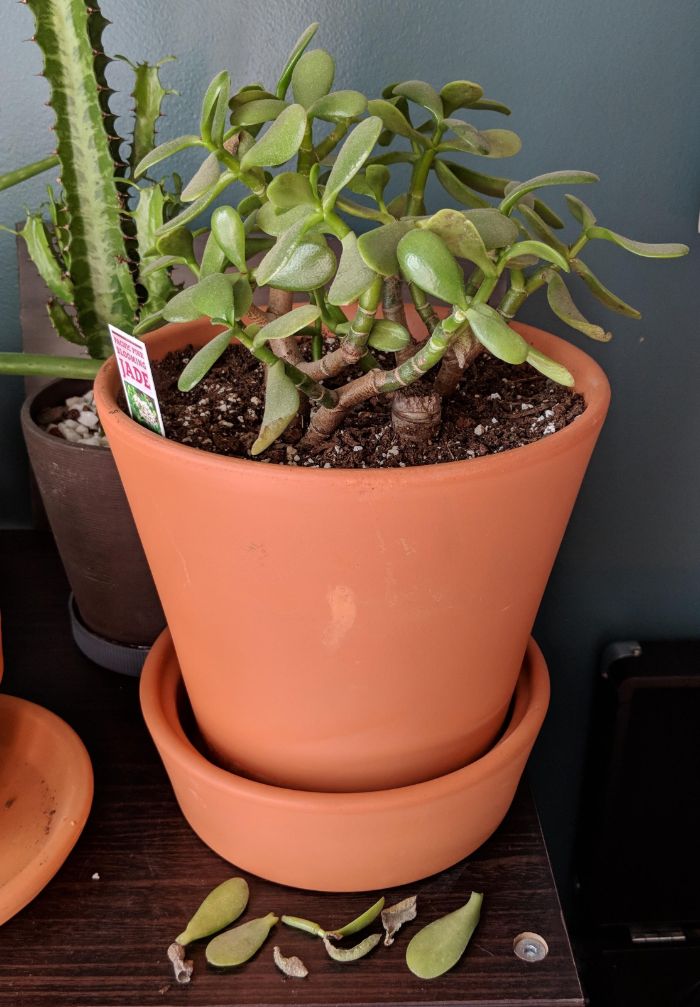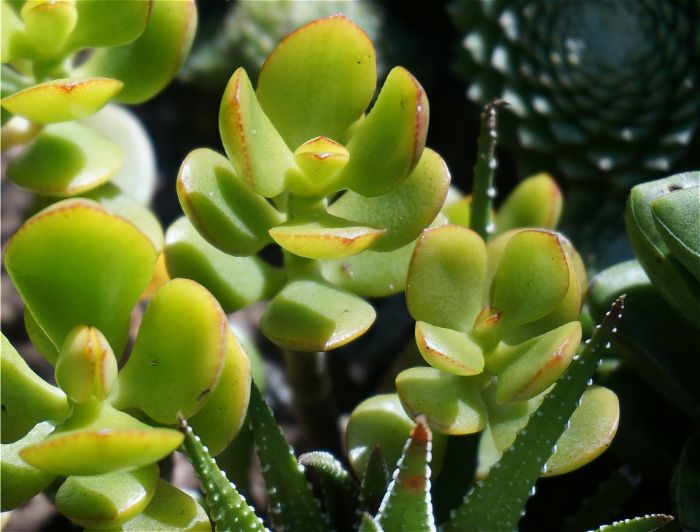While it’s not a particularly difficult plant to care for, sometimes a Jade plant can take a turn for the worse – and that can be quite disappointing. The first sign of an unhappy Jade plant is often the dropping of leaves. Understanding what upsets your Jade plant is important if you want to learn how to revive it and prevent this in the future.
Why is my Jade plant dropping leaves? A Jade plant can start dropping its leaves for the following 8 reasons:
- Incorrect watering (overwatering or underwatering)
- Poor drainage
- Poor soil quality
- Insufficient light
- Pest Infestation
- Temperature fluctuations
- Natural renewal of older leaves
- Using leaf shine products
The Jade plant, (Crassula ovata),is one of the most adaptable succulent plants in the world. Many people make the mistake of thinking that because it is adaptable, that it can get by with little to no attention.
Being adaptable doesn’t mean that you can get away with neglecting a Jade plant. This plant, mostly grown as foliage, makes for a great houseplant or garden plant. You simply have to put in a little bit of effort to keep it in good shape. I’ve written a complete jade plant care guide which covers everything you need to know to keep your jade plant in perfect health.
Read on to learn more about each of the 8 reasons why your Jade plant is dropping leaves and what you can do to revive it.
1. Incorrect Watering Causes Jade Plants To Drop Leaves
If you overwater or underwater your Jade plant, it may start dropping its leaves excessively. Being too wet or too dry can make the plant most unhappy.
Of course, Jade plants do love water and even though they do well in dry environments, you should still undertake to water the houseplant regularly. In fact, don’t be too hesitant when you water. You can completely soak the soil in the pot until the water starts leaking out the drainage holes.
However, don’t let the plant sit in the excess, drained water for more than about 30 minutes after watering. This will make the soil too wet, which is something that the Jade doesn’t like.
If you check the soil and it is damp, don’t water it again too soon. You should only water the plant again when the potting soil is dry.
2. Poor Drainage Can Cause Root Rot And Leaf Drop In Your Jade Plant
Poor drainage is a common reason why Jade plants drop their leaves. Well-draining soil is imperative for the long-term happiness of most succulents.
If your Jade plant’s soil doesn’t drain well, excess moisture can lead to root rot. When root rot sets in, it means that the water in the pot can’t be easily absorbed and this deters transport of water and nutrition to the leaves and the rest of the plant.
As a result, the leaves will fall off. Make sure that you have well-draining soil or use a wooden skewer to check that the soil is dry inside, before you water the plant again.
If you get your water schedule right and have decent soil that drains suitably, you can avoid excess leaf dropping.
3. Poor Soil Quality
Jade plants enjoy light fertilizing. If your Jade plant’s soil lacks sufficient nutritional value, it can stunt your plant’s growth and result in loss of leaves, but that’s not all.
Poor quality soil can also result in the plant and leaves shriveling or turning a yellow color and dying. Jade plants are succulents, so you don’t have to feed the soil/plant too often – typically they survive well in rocky environments and dry soils.
If you want to boost growth and bushiness, you should use a balanced houseplant fertilizer. I’ve had much greater success in growing vibrant healthy Jade Plants since I started using this fertilizer.
Mix the correct water to fertilizer ratio to avoid damaging your Jade and apply it sparingly to the soil.
There is such a thing as too much fertilizer! Jade plants typically enjoy feeding at the height of the growing season, which is in early to mid-summer. You should aim to add nutrition to the soil once a season or every 3 months.
4. Light Conditions
While Jade plants love full sunlight and will thrive in these conditions, you don’t specifically have to place your plant in direct sun. They can grow indoors or in shade, as long as there is sufficient natural bright light.
Jade plants with variegated leaves generally prefer less direct light and can be grown inside as long as natural light comes into the room. You can place your Jade plant in a southern window – if it gets 4 hours of direct sunlight, it will be happy and flourish, but it can get away with a bit less.
If your Jade plant is deprived of sunlight, it will start to drop its leaves. If you notice this happening, move your Jade plant to a sunnier or brighter spot.
5. Pest Infestation
Pest infestations and bug attacks can have a negative impact on a plant. How a plant recovers after an attack really depends on what type of pest attacked it and how much damage was sustained.
Mealybugs are prone to attacking Jade plants. This type of pest infestation can cause a Jade plant to start dropping its leaves. The good news is that Mealybugs are quite easy to get rid of.
You can help your Jade plant recover from a Mealybug infestation by removing each bug by hand. You can identify these bugs quite easily as they look like white spots usually found where stem and leaves meet.
Removing the bugs is best done with a rubbing alcohol-soaked swap. Gently wipe the plant down ensuring that you remove each bug. You can also use a general insecticide such as Malathion for controlling Mealybugs.
6. Temperature Fluctuations Can Cause Jade Plants To Drop Leaves
Most plants don’t like extreme or sudden temperature fluctuations so try not to move your plant around too much or leave it outside exposed to all manner of element changes.
If your Jade plant is exposed to high temperatures or very low temperatures, it could be the reason why it is dropping its leaves. The ideal temperature for a Jade plant is 65°F to 75°F.
Generally speaking, Jade plants can handle lower temperatures but don’t thrive in temperatures below 40°F. They specifically do not survive or do well with frost. This may cause a problem for your Jade plant if it is kept outside during the summer months and then winter comes around.
This can be quite a shock to the plant. When winter comes around, you can avoid leaves dropping from exposure to very low temperatures by bringing your plant inside for the coldest months of the year.
If you move your plant indoors for the winter, make sure that you situate it in an area that gets good air flow. If the temperature is too warm, which is usually the case when a Jade plant is positioned near a heater, the mature leaves can start to drop off and show soft leggy growth.
Move the plant to a more ventilated, cooler area to avoid leaf dropping and ensure that your plant perks up again.
7. Jade Plants Drop Older Leaves Naturally
Leaves dropping from your houseplant is not always a sign of doom and gloom. Your plant could be just fine.
Your Jade plant could be dropping its leaves simply because it is renewing older ones. This is the typical lifecycle of the Jade plant and is not something to be worried about. Jade plants naturally drop their older leaves as they age.
These are replaced with the growth of new leaves. If your Jade plant is dropping old leaves, this is completely normal. However, if your plant is excessively dropping leaves, it can be a sign of a problem and you should investigate all the possible reasons.
If you have had the plant for a while, you will know what is considered a normal leaf dropping rate for your particular plant. If your plant is suddenly dropping more leaves than normal, it could be a sign of the plant being unhappy or distressed.
8. Using Leaf Shine Products Can Cause Jade PLants To Drop Leaves
Many people mistakenly think that they should or can clean their houseplants with household detergents and leaf shine products. You should avoid doing this with your Jade plant as many of them don’t react well to chemicals of any variety.
Simply clean your plant with a damp cloth if it is dirty or dusty. Using leaf shine products can coat the leaf and cause yellowing, which eventually leads to leaves falling off.
If you have been using leaf shine products on your Jade plant and have noticed adverse effects, spend some time cleaning the plant with a cloth and lukewarm water.

How to Revive a Jade Plant
Many people worry that their Jade plant will never be the same after it has started looking bare and unhappy. The good news is that you can revive a Jade plant after it has started dropping its leaves with just a little bit of effort.
If your Jade plant is showing signs of distress by dropping its leaves, reviving it can be as simple as adjusting your watering schedule, adding a light fertilizer, checking for pest infestation, and placing it in the right spot. High and low temperatures and overwatering can also cause problems, so it is a good idea to check these conditions and adjust them too.
By doing things right with your Jade plant, you should be able to quite easily and effectively turn the situation around. Jade plants are quite amazing in that an entirely new plant can be grown by simply punching a leaf off and planting it.
If you are worried that your entire plant has sustained too much damage to revive, pinch some of the good leaves off and plant them. Soon new plants will be growing for you.
Will Jade Plants Leaves Grow Back?
Over time, your Jade plant should start to grow fresh, new leaves as it bounces back to better health. If you want to boost growth of new branches and leaves, there are things that you can do.
Below are a few ways to stimulate growth of new leaves and branches, and also to restore “bushiness”.
Prune And Trim The Plant Strategically
Carefully prune the plant directly after the winter season, when it is most primed to grow. Try not to over-prune your houseplants as this can set back their growth considerably.
Keep in mind that your Jade plant will still need leaves for photosynthesis. You should leave at least 70% – 75% of the leaves/foliage in place for the health of your plant. To avoid over pruning, plan to prune in stages over a number of weeks.
Pinch Back The Plant
Use your forefinger and thumbnail to pinch back young stems. This will encourage branching of the main stem and promote new leaf growth.
Cut The Leaf Axis
You can also cut branches at a leaf axis (where a leaf arises from the stem) and this will often encourage 2 new branches to develop. Do this often enough and you can really create a bushier, happier looking Jade plant.
Both of these techniques will encourage your Jade plant to grow new leaves and stems.
Last Word
Jade plants make for wonderful houseplants and very rarely suffer problems. If the leaves start wilting, withering or dropping off excessively, it’s a sure sign that your plant needs a bit of extra attention.
Ensure that you have created a prime living environment for your plant and your Jade should perk up and start flourishing once more.
For more information on how to grow wonderful succulents like Jade plants indoors, read my guide to indoor succulent care.

